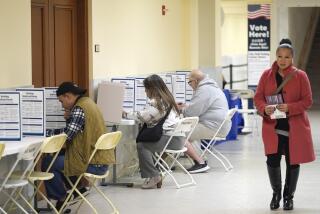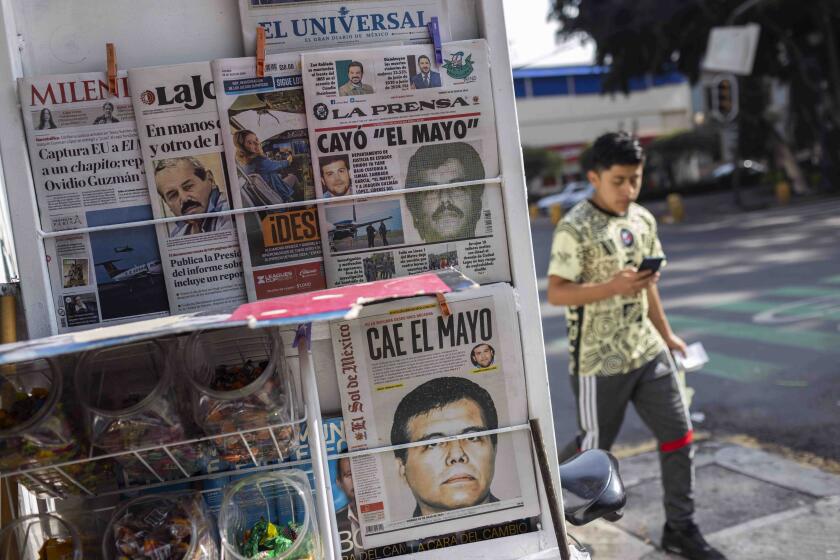Tragedy, time and again
LITTLETON, COLO. -- I cried a long time on my hotel bed that night, thinking about their faces. So many children -- 14, 15, 16 years old -- drawn tight with grief and exhaustion.
It was Tuesday, April 20, 1999, and two boys had just killed 12 classmates and a teacher at Columbine High School here in this Denver suburb. I had attended an evening prayer service, listening to students whisper their fragments of fear:
“He was shot twice. In the back.”
“Right in front of me.”
“My sister . . . “
I wanted so much to hold my 11-month-old baby, my Hannah, to keep her home, safe, forever.
In the years since, I felt that same shakiness with each school shooting I covered. In each city, on each campus, the same empty words echoed: It’s a senseless tragedy. Our hearts are broken. We never thought it could ever happen here.
So why did it happen, time and again?
There had to be answers. I sought assignments that would bring me close to those who might have them.
I drank iced tea with the mother of Mitchell Johnson, who, at age 13, ambushed his classmates in Jonesboro, Ark., killing five on a spring afternoon.
I followed a guard through the clanging doors of the Kentucky State Reformatory to sit in a bare room with Michael Carneal, who killed three high school classmates in West Paducah, Ky.
Parents, principals, police. Sociologists, psychologists. Neighbors, roommates, survivors. Over the years, I have asked the same questions of so many.
On Friday, the day after a graduate student killed five in a geology class at Northern Illinois University, I went back and read those old stories, seeking answers, hoping for something more than “senseless.”
When Mitchell Johnson and his friend Andrew Golden, 11, killed four children and a teacher at Westside Middle School in 1998, the families of Jonesboro also reached for explanations.
They searched for warning signs they may have overlooked, and found a few: Mitch had a quick temper; he was once suspended for fighting.
But his mother said that was not the Mitch she knew. He sang for elderly shut-ins with his church choir; he rocked his little sister to sleep every night; he was kind; he got good grades.
“You can drive yourself crazy with the what-ifs, the should-have-knowns,” said his mother, Gretchen Woodard. “There’s nothing I could have or would have done different.”
Sometimes, of course, the warning signs are clear -- at least in hindsight. Seung-hui Cho, who killed 32 at Virginia Tech last spring, alarmed professors and classmates with glares and dark, violent writings.
At the Appalachian School of Law in 2002, failing student Peter Odighizuwa was known for his temper even before he killed two faculty members and a classmate.
But other shootings defied explanation.
“You want to look for a pattern, but the deeper you look, the less specific it gets,” said Jeffrey Sprague, co-director of the Institute on Violence and Destructive Behavior at the University of Oregon.
Some of it may be today’s culture, what Sprague called “mean-world syndrome.” Kids see cruelty in movies and video games -- and, too often, on the news every time there’s a rampage in a church, a mall, a school. If they’re already a bit unbalanced, “that can become their reality,” Sprague said. “They will pick up on those cues. . . . And it becomes something they want to do themselves.”
Guns are widely available, and even children can get their hands on rifles and semiautomatic pistols. That’s a factor, certainly.
In many families, both parents work, and have less time to keep close watch on their kids. That could be a factor too. As could the high divorce rate. Pressure to succeed in school. Cutbacks in mental-health care.
“All the answers you can come up with are right, in their own context,” Sprague said.
Which only leads to more questions.
“Years ago, when students were upset, they protested, they had sit-ins, they carried on with their parents, but you didn’t have this kind of rage or violence,” said Carolyn Reinach Wolf, who advises college administrators on handling high-risk students. “Why is this happening? Why is it being directed toward their peers? And how do you set up systems to address that?”
Bill Bond has spent a decade trying to address one possible cause; he teaches high-school principals how to stop students from bullying. He has poured his life into that work. On Friday, heartbroken over five school shootings in a week, he had to wonder why.
“It doesn’t seem to do any good,” Bond said.
“Different names of schools, different names of kids, but really, it’s the same story, again and again,” he said. “These kids don’t have hope. They can’t see the future.”
Bond was the principal at Heath High School in December 1997 when Carneal killed three classmates and wounded five during a prayer circle on a Monday morning. Five years later, I visited Carneal in the psychiatric ward of the Kentucky State Reformatory.
He sat in a too-big prison jumpsuit, his skin pasty, his eyes flat, and he said he didn’t know why he had done it. One night, he was playing chess with his dad. The next morning, he was killing his classmates.
He knows now that he was mentally ill; he was hearing voices, seeing monsters. Still, he thought there ought to be more to it than that: a reason, a motive. He had none. “That makes it all that much worse,” he said.
Carneal never told his parents about the voices he heard. That’s not uncommon, especially among teens. Mental illness is far harder to recognize and diagnose when it’s just beginning to take root.
Only one in three children with mental disorders gets treatment, according to Patrick Tolan, director of the Institute for Juvenile Research at the University of Illinois at Chicago.
When Tolan was growing up, his teachers used to run duck-and-cover drills in case of nuclear attack. Tolan remembers how real that threat felt. He thinks today’s students must feel the same shadow. Only for them, the threat is not a Russian bomb. It’s a gunman in geology class.
“They have to be prepared for what they can’t predict,” he said. “That’s what this has become.”
Imoved to the Denver suburbs with my family almost three years ago. We live about 10 miles from Columbine.
I saw the high school again in October, when the city opened a memorial to the victims. It’s a beautiful place, and as I read the inscriptions, I thought of Rachel.
Rachel Scott died on the lawn outside Columbine. She was 17, and she had many, many friends, who told me all about her: How she cut off her gorgeous brown hair for a part in the school play -- she never did anything halfway. How she -- alone among poofy pastels -- wore a sleek black dress to the prom. How she loved to write. How she sparkled.
I wrote a lot about Rachel that week. She made me think of my little Hannah, just learning to walk.
Hannah is almost 10 now. She wears mismatched socks every day, to be colorful. She spends hours writing her own fairy tales. I look at Hannah, and I think of Rachel.
On Friday morning, my husband and I sat down with Hannah and her younger brother and sister for a talk before school. We told them what to do if they ever spotted anyone with a gun in school: Forget calling 911. Don’t worry about finding a teacher. Hit the floor. Crawl away and hide.
I hated to scare them. But my search for answers had led to only one truth:
It will happen again.
--
stephanie.simon@latimes.com
More to Read
Sign up for Essential California
The most important California stories and recommendations in your inbox every morning.
You may occasionally receive promotional content from the Los Angeles Times.










